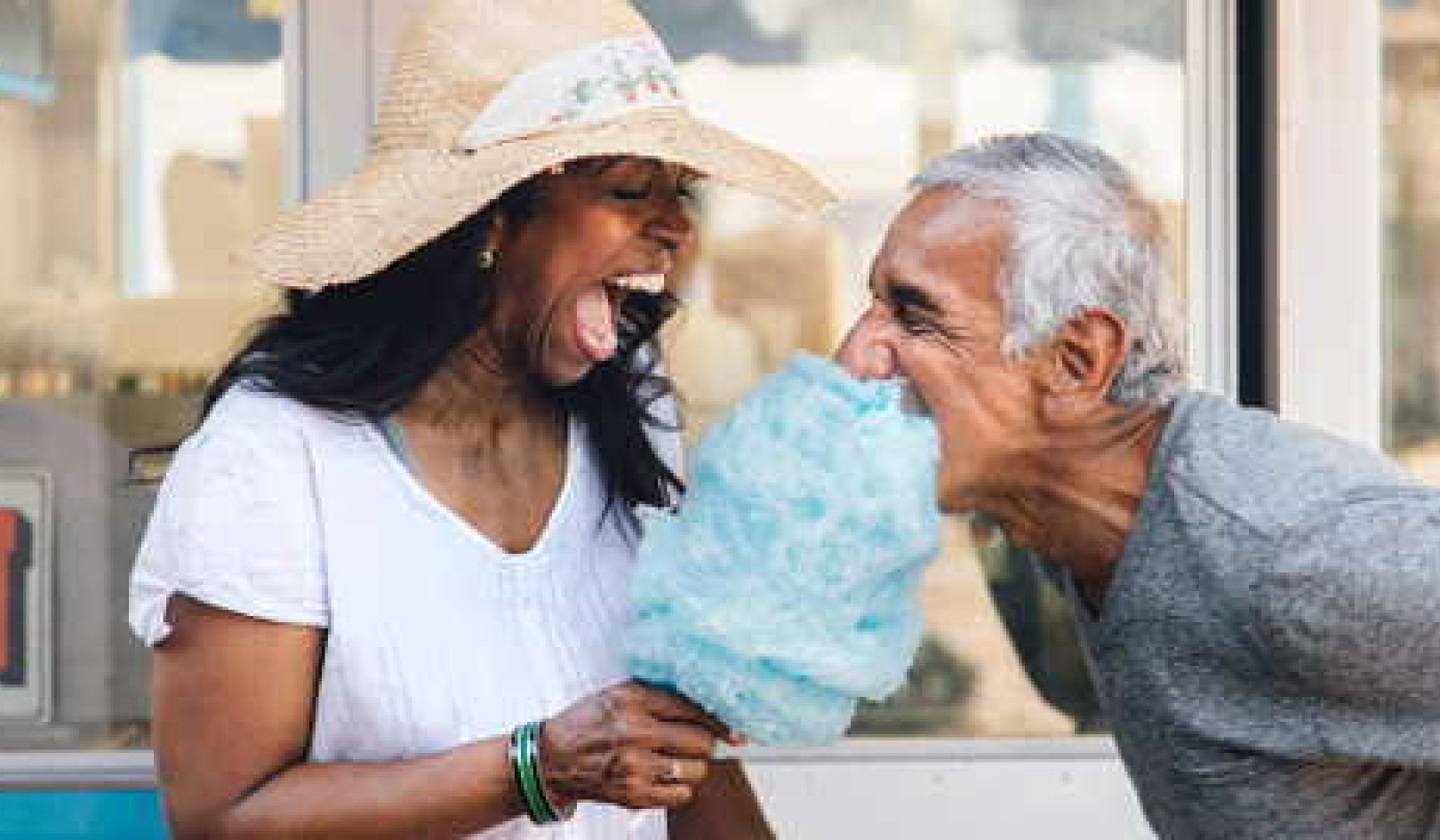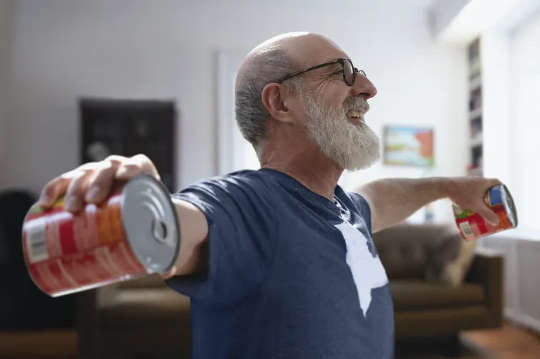
Working out strengthens more than just your muscles – it strengthens your immune system, too. SelectStock/E+ via Getty Images
Older adults, especially those over 65, have five times the risk of hospitalization and 90 times the risk of death from COVID-19 compared with younger adults.
According to the U.S. Centers for Disease Control and Prevention, 78% of the more than 114,000 COVID-19 related deaths between May and August 2020 were people age 65 and older. Many of those individuals had compromised immune systems due, in part, to a variety of other health conditions including obesity, cardiovascular disease, diabetes, respiratory disease and hypertension. The CDC suggests these additional health problems could lead to increased severity of COVID-19.
The good news, however, is that regular exercise and cardiorespiratory fitness can significantly reduce the risk COVID-19 poses to older adults by improving overall health and boosting the immune system.
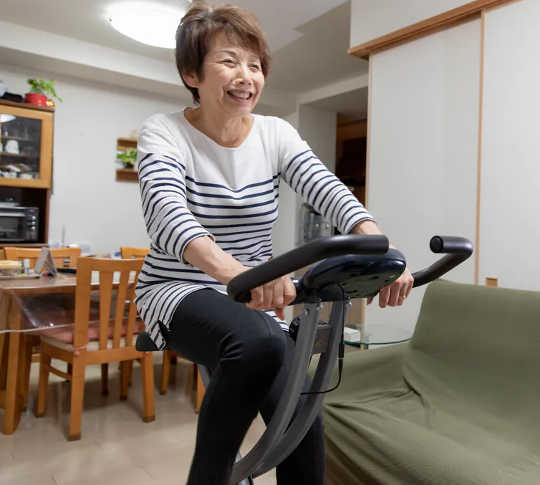
Exercising circulates your immune cells. kumikomini/E+ via Getty Images
Now is not the time to stop moving
Staying active can be challenging, as many older adults are remaining at home most, if not all, of the time to avoid the novel coronavirus. As a result, the very changes in lifestyle that keep people safe from exposure can also result in their adopting sedentary habits – which leave people vulnerable to serious health consequences should they get COVID-19.
Exercise, especially aerobic exercise, which gets the heart pumping hard and improves cardiorespiratory fitness, has multiple health benefits, including reduced risk for stroke, heart attack, depression and age-related cognitive decline and Alzheimer’s disease.
The U.S. Department of Health and Human Services recommends that older adults get at least 150 minutes a week of moderate- to vigorous-intensity exercise. That means three 50-minute sessions each week, or a little over 20 minutes per day.
Firing up the immune system
Not only can exercise enhance overall health, it can also specifically improve immune system response, which is critical to surviving COVID-19.
As humans age, the immune system becomes progressively less effective at responding to new viruses because of an age-related weakening of the immune system, also known as “immunosenescence.”
The good news is that exercise improves the efficiency of the immune system in people of all ages. Every session of exercise mobilizes billions of immune cells throughout the body. The more immune cells circulate, the better they are at spotting and attacking potential pathogens.
Although there is no data yet on how exercise and cardiorespiratory fitness can reduce risk of hospitalization or death from COVID-19, previous studies show that regular exercise improves the immune response to other viral infections. Regular exercise has also been shown to lower the risk of death from viral and respiratory illnesses. Furthermore, increased physical activity is known to improve and prolong the immune response from the flu shot.
Working out at home
How can older adults safely exercise and keep aerobically fit while stuck mostly at home without access to a gym? At the Aging & Brain Health Alliance at Rutgers University-Newark, we have been offering virtual exercise classes, by video conference or phone, for seniors using materials they can easily find around the home.
Here are a few suggested exercises from our fitness classes you can do on your own safely at home.
One of the best exercises to get you started on your fitness journey is to walk the floors of your home. Whether in a house or an apartment, take time every hour to get up and just walk. Set aside five to 10 minutes with the goal of increasing your daily step count and improving your overall cardiorespiratory health. Challenge a family member to join you and make it fun.
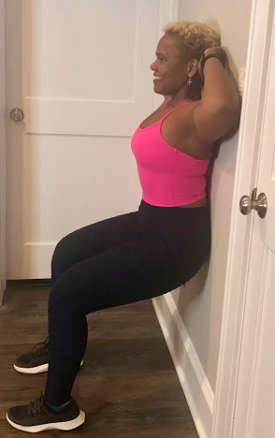 Use your walls to boost your immune system. Lisa Charles, CC BY-SA
Use your walls to boost your immune system. Lisa Charles, CC BY-SA
You should also take advantage of your walls. Wall sits are an easy way to engage your muscles and work your body.
Simply stand with your back against a wall; step your feet two feet away from the wall and open your legs hip-distance apart. While keeping your shoulders against the wall, slowly and carefully lower your body until you are sitting in an imaginary chair.
Remember to keep breathing, inhaling through your nose and exhaling from your mouth, and you will begin to feel the burn in your leg muscles.
Try coming up and down five times if you feel safe and comfortable doing so. (For extra security, keep a chair or something else near by to hold on to if you lose your balance.)
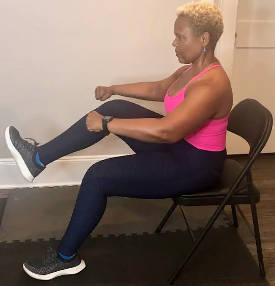 How to work out your core while seated. Lisa Charles, CC BY-NC-SA
How to work out your core while seated. Lisa Charles, CC BY-NC-SA
Finally, use a chair. Sit at the edge of a solid chair focusing on maintaining good posture. Plant your feet hip-distance apart; take a big inhale and, on the exhale, slowly lift one knee toward your chest.
This is a seated crunch and it will engage your deep core muscles. Complete five of these knee lifts on each side, making sure to do each knee lift on the exhalation.
Exercise habits developed during this period of COVID-19 – and maintained after the threat has passed – will support your immune health for years to come.
About the Authors
Mark A. Gluck, Professor, Center for Molecular and Behavioral Neuroscience, Rutgers University - Newark ; Bernadette A. Fausto, Postdoctoral Fellow, Center for Molecular & Behavioral Neuroscience, Rutgers University - Newark , and Lisa Charles, Fitness/Wellness Research Coordinator for the Rutgers Aging Brain Health Alliance, Rutgers University - Newark
This article is republished from The Conversation under a Creative Commons license. Read the original article.
Books on Exercise from Amazon's Best Sellers list
The Four-Pack Revolution: How You Can Aim Lower, Cheat on Your Diet, and Still Lose Weight and Keep It Off
by Chael Sonnen and Ryan Parsons
The Four-Pack Revolution presents a total-life approach for attaining health and fitness goals without the hard work and suffering.
Click for more info or to order
Bigger Leaner Stronger: The Simple Science of Building the Ultimate Male Body
by Michael Matthews
If you want to build muscle, lose fat, and look great as quickly as possible without steroids, good genetics, or wasting ridiculous amounts of time in the gym and money on supplements, then you want to read this book.
Click for more info or to order
The Women's Health Big Book of Exercises: Four Weeks to a Leaner, Sexier, Healthier You!
by Adam Campbell
The Women's Health Big Book of Exercises is the essential workout guide for anyone who wants a better body. As the most comprehensive collection of exercises ever created, this book is a body-shaping power tool for both beginners and longtime fitness buffs alike.
Click for more info or to order
Bodyweight Strength Training Anatomy
by Bret Contreras
In Bodyweight Strength Training Anatomy, author and renowned trainer Bret Contreras has created the authoritative resource for increasing total-body strength without the need for free weights, fitness machines, or even a gym.
Click for more info or to order
The Men's Health Big Book of Exercises: Four Weeks to a Leaner, Stronger, More Muscular You!
by Adam Campbell
The Men's Health Big Book of Exercises is the essential workout guide for anyone who wants a better body. As the most comprehensive collection of exercises ever created, this book is a body-shaping power tool for both beginners and longtime fitness buffs alike.





















